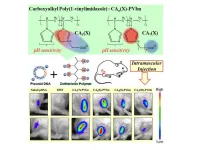(Press-News.org) In Canada, rates of hypertensive disorders of pregnancy (HDP) have increased, but the good news is there has been a decline in some related health conditions, according to new research published in CMAJ (Canadian Medical Association Journal) https://www.cmaj.ca/lookup/doi/10.1503/cmaj.231547.
Hypertensive disorders of pregnancy include chronic hypertension (high blood pressure), gestational hypertension, and preeclampsia or eclampsia. These disorders affect 5%–10% of pregnancies worldwide, and cause more than 50 000 maternal deaths and 500 000 deaths in fetuses and infants every year.
A large study of more than 2.8 million births in hospital in Canada (excluding Quebec) between 2012 and 2021 dentified females with HDP, with the aim of understanding trends in HDP and related health outcomes. Over the study period, the rate of any HDP increased from 6.1% to 8.5% in absolute numbers, with a relative increase of 40%. Pre-existing hypertension temporally increased from 0.6% to 0.9%, gestational hypertension rose from 3.9% to 5.1%, and preeclampsia from 1.2% to 2.6%
The researchers noted several trends. Rates of HDP were higher in females under age 20 and in those older than 34 years. There was also variability in rates across provinces and territories, with the Northwest Territories (6.5%) and Ontario (6.9%) having the lowest rates, and the highest rate (10.7%) in Newfoundland and Labrador.
The authors adjusted for risk factors for HDP, including maternal age, number of previous livebirths, pre-existing diabetes, and rural residence, but doing so did not significantly affect the risk of HDP. “[T]he rise in HDP may be explained by factors that we did not account for, including body mass index (BMI),” writes lead author Dr. Susie Dzakpasu, senior epidemiologist at the Maternal and Infant Health Section of the Public Health Agency of Canada, with coauthors. “High BMI is a known risk factor for hypertension, including during pregnancy.”
Between 2015 and 2021 in Canada, rates of overweight or obese BMI status increased from 41% to 48% among females aged 18–34 years, and from 56% to 64% in those aged 35–49 years. The authors also found that provinces with higher rates of overweight and obesity had higher rates of HDP.
“[D]ownward trends in other adverse outcomes suggest that the clinical management of HDP may have improved over time,” write the authors. “This underscores the importance of standard measurement of blood pressure at each prenatal visit and the institution of evidence-based antihypertensive therapy.”
In a related editorial https://www.cmaj.ca/lookup/doi/10.1503/cmaj.241017, Dr. Catherine Varner, deputy editor, CMAJ, writes that the “growing population of high-risk obstetrical patients should alert health policy-makers that more people need easily accessed, specialized obstetrical care.”
Females with hypertension and other disorders should be monitored in the early postpartum period, yet there is a shortage of qualified health care providers.
The findings of Dzakpasu and colleagues “highlight the increasing demand for obstetrical care providers with the expertise to care for high-risk patients, supported by appropriate models of care both before and after delivery. As the number of obstetricians will be unable to conceivably meet the needs of the growing population entering their reproductive lives with more comorbidities than the preceding generation, scaling team-based maternity care may help people receive the right care, at the right time, in the right place, by the right provider,” Dr. Varner concludes.
END
Hypertensive disorders of pregnancy increasing in Canada
2024-07-29
ELSE PRESS RELEASES FROM THIS DATE:
Is free genetic testing really free?
2024-07-29
Free genetic testing, offered partially or fully subsidized by industry, may have trade-offs, and health systems in Canada must carefully weigh potential clinical, ethical, and legal considerations to protect patient data, authors argue in a CMAJ (Canadian Medical Association Journal) commentary https://www.cmaj.ca/lookup/doi/10.1503/cmaj.231588.
“Near- and long-term expansion in no-cost testing and industry partnership in genetics, with patient data as the commodity, is likely,” writes Kirsten ...
Health: Short-term vegan diet associated with reductions in biological age estimates
2024-07-29
Eating a vegan diet for eight weeks is associated with reductions in biological age estimations based on levels of DNA methylation — a type of chemical modification of DNA (known as an epigenetic modification) that alters gene expression but not DNA itself. Previous research has reported that increased DNA methylation levels are associated with ageing. The findings, which are based on a small randomised controlled trial of 21 pairs of adult identical twins, are published in BMC Medicine.
Varun Dwaraka, Christopher ...
Evidence-based information combats misleading and false claims on the internet and social media about the anti-Mullerian hormone test
2024-07-29
Researchers in Australia have found that when women are given accurate information about a test that indicates the number of eggs in their ovaries, they have less interest in taking the test compared to women who viewed information available online.
The researchers initiated the study, which is published today (Monday) in Human Reproduction [1], one of the world’s leading reproductive medicine journals, because of the large amount of misleading and incorrect information promoted to women about the anti-Mullerian hormone (AMH) test on websites, including fertility clinic websites, and via social media.
AMH ...
Steel industry’s net zero drive could make lower-grade iron ore viable
2024-07-29
A decarbonised steel industry that includes carbon dioxide removal techniques in its net zero arsenal could use lower-grade iron ore, according to a new study.
Steel accounts for 5-8% of carbon dioxide emissions globally. Its total emissions have risen over the past decade, largely due to increased demand.
The International Energy Agency has stated that, without innovation, the scope to limit emissions is ‘limited’. Therefore, the commercialisation of new zero-emission production processes is critical.
Innovative ...
Plasma phosphorylated tau 217 and Aβ42/40 to predict early brain Aβ accumulation in people without cognitive impairment
2024-07-28
About The Study: The results of this cohort study suggest that combining plasma p-tau217 and Aβ42/40 levels could be useful for predicting development of Aβ pathology in people with early stages of subthreshold Aβ accumulation. These biomarkers might thus facilitate screening of participants for future primary prevention trials.
Corresponding Authors: To contact the corresponding authors, email Oskar Hansson, M.D, Ph.D. (Oskar.Hansson@med.lu.se) and Shorena Janelidze, Ph.D. (shorena.janelidze@med.lu.se).
To access the embargoed study: Visit our For The Media website at this link https://media.jamanetwork.com/
(doi:10.1001/jamaneurol.2024.2619)
Editor’s ...
MRI signature of α-synuclein pathology in asymptomatic stages and a memory clinic population
2024-07-28
About The Study: In this cohort study, seed amplification assays (SAA) α-syn+ was consistently associated with nucleus basalis of Meynert (NBM) atrophy already during asymptomatic stages. Further, in memory clinic cognitively impaired populations, SAA α-syn+ was associated with NBM atrophy, which partially mediated α-syn–induced attention/executive impairment.
Corresponding Authors: To contact the corresponding authors, email Laura E.M. Wisse, Ph.D. (laura.wisse@med.lu.se) and Oskar Hansson, M.D., Ph.D. (oskar.hansson@med.lu.se).
To access the embargoed study: Visit our For The Media website at this link https://media.jamanetwork.com/
(doi:10.1001/jamaneurol.2024.2713)
Editor’s ...
Blood biomarkers to detect Alzheimer disease in primary care and secondary care
2024-07-28
About The Study: The amyloid probability score 2 (APS2) blood test and percentage of p-tau217 alone had high diagnostic accuracy for identifying Alzheimer disease among individuals with cognitive symptoms in primary and secondary care using predefined cutoff values. Future studies should evaluate how the use of blood tests for these biomarkers influences clinical care.
Corresponding Authors: To contact the corresponding authors, email Sebastian Palmqvist, M.D., Ph.D. (sebastian.palmqvist@med.lu.se) and Oskar Hansson, M.D., Ph.D. (oskar.hansson@med.lu.se).
To access the embargoed study: Visit our For The Media website at this link https://media.jamanetwork.com/
(doi:10.1001/jama.2024.13855)
Editor’s ...
Changes in Alzheimer disease blood biomarkers and associations with incident all-cause dementia
2024-07-28
About The Study: Plasma biomarkers of Alzheimer disease (AD) neuropathology, neuronal injury, and astrogliosis increase with age and are associated with known dementia risk factors. AD-specific biomarkers’ association with dementia starts in midlife whereas late-life measures of AD, neuronal injury, and astrogliosis biomarkers are all associated with dementia.
Corresponding Author: To contact the corresponding author, Priya Palta, Ph.D., M.H.S., email priya_palta@med.unc.edu.
To access the embargoed study: Visit our For The Media website at this link https://media.jamanetwork.com/
(doi:10.1001/jama.2024.6619)
Editor’s ...
New and improved drug delivery molecules for skeletal muscle
2024-07-27
Tokyo, Japan – Researchers from Tokyo Metropolitan University have created a new drug delivering molecule, a zwitterionic polymer complex that can help get plasmid DNA inside cells when injected into skeletal muscle, a crucial step in the expression of therapeutic RNA and proteins. The new compound effectively bound to plasmid DNA without affecting its structure. Injected into mouse muscles, the team observed widespread gene expression, promising applications to treatments of serious muscle diseases.
Drug delivery systems underpin many of the clinical breakthroughs of our age. For example, ...
UC San Diego Health ends negotiations with Tri-City Medical Center Healthcare District
2024-07-27
UC San Diego Health has ended more than nine months of negotiations for a potential partnership with the Tri-City Medical Center (TCMC) Healthcare District.
A final revised offer was presented to the TCMC Healthcare District on July 24 and no agreement was reached.
Highlights of the final proposal for TCMC included a financial recovery and growth plan that included:
$100 million infusion of cash within the first two years plus other financial supports, including a line of credit designed to protect the financial stability of TCMC during the first five years.
All assets and liabilities would transfer to UC San Diego Health, including employment ...


